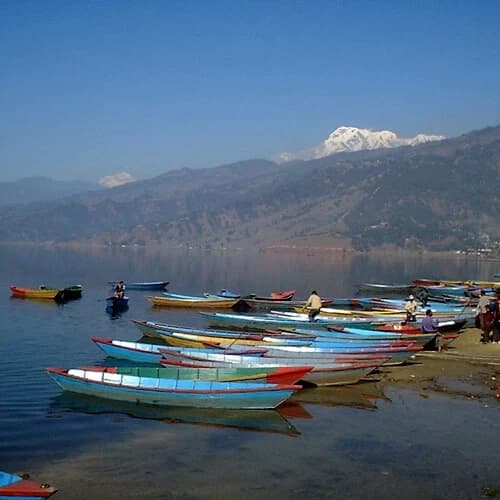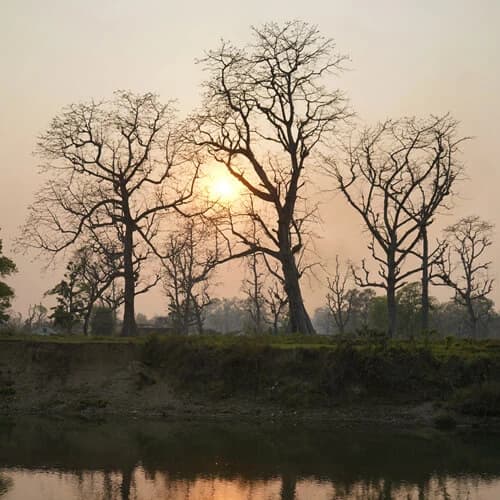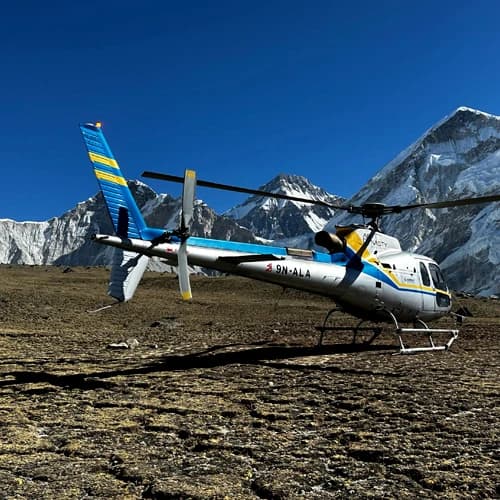Best Time and Weather of 7 Days Annapurna Base Camp Trek
Deciding the time of the year to plan your trek to Annapurna Base Camp can make all the difference—the diverse landscapes of the region and high-altitude climate offer distinctive experiences each month. While the trek is technically possible year-round, spring and autumn stand out as the most favorable times for their stable weather, clear mountain views, and enjoyable temperatures. Below is a closer look at what each season offers and why they're the top picks for trekkers from around the world.
Spring (March, April, May)
In spring, the Annapurna region comes alive with blooming rhododendrons and fresh wildflowers. Daytime temperatures at mid-altitudes range between 10–20 °C, dipping to −5 °C near Base Camp. Clear morning skies provide spectacular visibility of peaks like Annapurna I and Machhapuchhre before occasional afternoon clouds roll in. Trails are mostly dry with moderate foot traffic, and trekkers benefit from longer daylight hours. Plus, the lush forests and colorful blossoms create a fairytale-like setting that many find irresistible.
Autumn (September, October, November)
Post-monsoon autumn brings some of the crispest air and most stable weather of the year. At Base Camp, daytime highs hover around 12 °C, and nights can reach down to −6 °C. The skies are a striking sapphire blue, offering razor-sharp views of the Annapurna massif, Hiunchuli, and Dhaulagiri—ideal for photographers and summit lovers. Cooler mornings and evenings enhance the hiking experience, and though it's a popular season, the festive buzz in villages adds warmth and charm.
How Challenging is the 7 Days Annapurna Base Camp Trek?
The 7-day ABC Trek is a moderate-difficult trek with its distinctive challenges, but even first-time trekkers can complete it. Compared to other popular treks in Nepal, this Himalayan journey falls on the shorter and easier side, making it ideal for even beginners trekkers. However, it is essential to note that travelers must make proper physical preparations.
Additionally, as the trek takes you to high-altitude regions with frequent steep ascents and descents along the way, you must have the mental resilience to push yourself. To have an enjoyable and safe journey, you must be aware of concerns related to Annapurna Base Camp trek difficulty, such as:
- Elevation Gain: The oxygen level at higher altitudes is significantly low, which can cause illnesses like Acute Motion Sickness (AMS).
- Unpredictable Weather: It is essential to recognize the challenges of traveling in various seasons. The weather conditions might change drastically, leading to heavy snowfall or rainfall at any time of the day or night.
- Terrain: This expedition's trail features several steep ascents and descents. Risk factors include injury from slips and falls when the route is wet from snow and rain.
- Distance: The standard 7-day Annapurna Base Camp is approximately 110 km or 68 miles. Travelers must hike for 5-8 hours and cover 8-12 km daily.
Note: The challenges may seem daunting at first glance, but they can be tackled with proper preparation and good physical fitness.
Physical Training for the Annapurna Base Camp Short Trek 7 Days
Preparing for the Annapurna Base Camp trekking 7 Days is more than just picking the right month and packing the essential gear. It's about training, building stamina, strength, and mental grit to face 5–7 hours of daily walking at high altitude. Fitness experts and seasoned guides recommend a structured plan consisting of three to five cardiovascular sessions per week. We suggest incorporating workouts like running, cycling or brisk hiking paired with leg and core exercises such as squats, lunges, planks, and step-ups. Here are some additional tips to help you prepare for the adventurous trek to the ABC.
- Training hikes with a 5–10 kg backpack, once or twice a week, will help acclimate your body to carrying weight over uneven terrain.
- Hydration is crucial for your body to avoid overexertion, and it is recommended to drink 3 to 4 liters of water daily.
- Begin altitude-aware breathing exercises to prepare for thinner air above 3,000 m.
- Enhance your flexibility by practicing yoga or dynamic stretching, which improves your balance and helps prevent injuries and sprains during long treks.
- By training consistently for at least 8 to 12 weeks, you’ll be able to build not just physical readiness but the confidence to embrace every step of this epic Himalayan adventure.
Note: As Reddit users have emphasized, walking at a steady, moderate pace keeps fatigue at bay and wards off knee strain. Therefore, buying a pair of trekking poles with knee and back support is a wise move.
Acclimatization and Prevention of Altitude Sickness
During the trek to Mount Annapurna's Base Camp, it is essential to be cautious regarding the elevation gain. As altitude sickness can affect anyone regardless of their fitness, condition, and health, travelers must be wary and listen to their bodies. You must be alert for warning signs of altitude sickness, including:
- Headache
- Shortness of breath/Change in breathing pattern
- Dizziness/Lightheadedness
- Nausea/Vomiting
- Fatigue/Weakness
- Insomnia
Keeping the risk of altitude sickness in our concern, we have planned our 7-day ABC trek with strategic rest stops for acclimatization. You will gain elevation during the day but descend to a lower altitude at night to adapt to the changing atmosphere. To further prevent the risk of altitude sickness, here are some steps we recommend you take during the trek to Annapurna Base Camp:
- It is essential to pause and take frequent rest along the trail.
- Walk at a slow and gradual pace, avoiding pushing yourself when you are tired.
- Drink at least 2 to 3 liters of water every day to stay hydrated.
- Consume natural remedies like ginger tea and garlic soup for soothing effects.
- Maintain a nutritionally rich and carbohydrate-rich diet to sustain energy and fuel your muscles.
- Get at least 8 to 10 hours of sleep every day.
- Avoid drinking excessive alcohol, tobacco, and cigarettes.
Note: With gradual ascent, solid hydration, balanced meals, and vigilance, you're giving yourself the best chance to conquer ABC safely and fully savor your Himalayan journey.
Add-On Options & Customization
One of the most significant advantages of choosing the 7-day Annapurna Base Camp trek l is the flexibility to customize your travel experience. Whether you're seeking more cultural immersion, epic sunrise views or want to take it a bit slower, there are several add-on options to make your trek more personal and rewarding.
A popular extension is the Poon Hill detour, which adds just 2 days. You'll hike to a 3,210-meter viewpoint known for arguably the best sunrise panorama in the Annapurna region, showcasing peaks like Dhaulagiri, Annapurna South, and Machhapuchhre bathed in golden light. For trekkers who want to explore a more off-the-beaten-path experience, the Mardi HimalHimal and Annapurna Base Camp are ideal options as well. This route takes you through peaceful trails with fewer crowds and spectacular ridge-line views.
You can also upgrade your travel comfort by adding Kathmandu–Pokhara flights to avoid the long, bumpy drive—these are quick (30 mins) and available daily, often priced around USD 120. Some trekkers opt to add a Chitwan jungle safari post-trek—an ideal way to relax and spot rhinos, elephants, and gharials after their time in the mountains. These add-ons not only enhance comfort and adventure but also let you shape the journey around your pace and preferences—something many travelers deeply value on a trek of this magnitude.
Our Sustainable Efforts on 7 Days Annapurna Base Camp Trek
Our dedication to sustainable trekking on the Annapurna Base Camp is an essential part of our work ethics and holds the utmost importance to us. Our main goal is straightforward: we strive to help preserve the Annapurna region and ensure we leave no negative impact. We warmly invite you to join us in this epic adventure and respect the local culture, environment, and community guidelines. You can genuinely contribute to this effort during your travel in several ways, including:
- By consciously opting for biodegradable products and avoiding plastic materials.
- Always keep your surroundings clean and free from litter.
- Maintaining a calm and respectful presence so as not to disturb the precious wildlife.
- Actively supporting the local economy, which directly helps the communities you meet along the trail.
Why Choose Outfitter Nepal?
With over 15 years of local experience, Outfitter Nepal is a trusted, locally owned trekking company founded by well-experienced individuals in the tourism industry. To validate our authenticity, we are recognized by governing bodies in the tourism industry, such as the Trekking Association of Nepal (TAAN) and the Nepal Mountaineering Association (NMA), as members.
Our guides, who have intimate knowledge of the Himalayas, will provide you with top-notch services, ensuring your ABC Trek 7 Days benefits from actual expertise and authentic insights. Additionally, as your well-being is our top priority, we will also maintain close monitoring of your health throughout the trek, especially at high altitudes.
Additionally, our commitment extends beyond guiding; we dedicate ourselves to sustainability practices by actively leading plastic-free initiatives, all aimed at preserving the pristine mountain environment for generations to come
Our holistic approach, which blends seasoned expertise with a deep focus on safety, sustainability, and personalized experiences, ensures your trek is truly an exceptional and responsible adventure.





